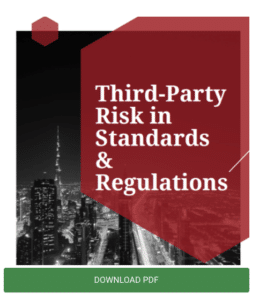Managing Third-Party Vendor Regulatory Compliance
Data breaches are a hot topic and will undoubtedly get even hotter. Cybersecurity for your own enterprise isn’t enough — you must evaluate your vendors and determine if they’re prepared to resist cyberattacks.
The increase in data breaches has only led to more regulatory scrutiny. Regulatory focus on third-party vendors was already increasing after the 2008 financial crisis, but has reached a fever pitch in recent years. New data privacy laws often make companies liable for the mistakes of their vendors, even as businesses are relying on outsourcing more and more. So this reliance on vendors, suppliers and subcontractors means increased liability.
Under a law like the CCPA, your organization is responsible for data breaches of third-party and even fourth-party vendors that have access to your customers’ data. A lack of preparation can lead to loss of consumer confidence, reputational damage, and mounting fines which can put a decided dent in your bottom line. For small and mid-sized businesses, the damage can be devastating. So it’s time to look more closely at the regulatory requirements for your vendors.
What are the most prevalent security regulations for vendors?
Vendors are potentially the weakest security link in a company’s cyber ecosystem. These are the most-prevalent security regulations to derive the business’ liabilities on a third-party scale:
- National Institute of Standards and Technology (NIST):
- NIST 800-53
- Cyber Security Framework (CSF)
- International Organization for Standardization (ISO)
- ISO 27001
- ISO 27701
- The General Data Protection Regulation (GDPR)
- Health Insurance Portability and Accountability Act (HIPAA)
- Payment Card Industry Security Standard Council (PCI-DSS)
- Control Objectives for Information and Related Technologies (COBIT)
- California Consumer Privacy Act (CCPA)
- Shield Act of New York
- Online Trust Alliance (OTA)
The threats of data breaches and non-compliance have become even more destructive during the coronavirus (COVID-19) crisis. The transition to remote work and reliance on unsecured sever access and videoconferencing have created new entry points for data breaches.
You need an effective VRM solution for compliance checks
How can you protect customer data and your hard-earned brand name in this continuously evolving regulatory and workplace landscape? A robust vendor risk management (VRM) solution can help you monitor the cyberhealth of your vendor ecosystem.
An effective VRM solution will include:
- Functionalities to assess cybersecurity threats and enable vendors to stay in compliance.
- The ability to measure the compliance level of any company or third party with regulations and standards, including NIST 800-53, ISO 27001, PCI-DSS, HIPAA, COBIT, OTA, GDPR and Shared Assessments.
- A Cyber Risk Score for each vendor to create a clear picture of where its security position stands.
The net-net? With the right solution, you should be able to manage vendor risk and ensure third- and fourth-party vendors are secure and compliant.
A resource for building third-party compliance
VendorInsight®, part of Mitratech’s Enterprise Compliance Suite (ECS), is partnering with Black Kite to help you drill down into the details on how to defend against increasing cyberattacks and breaches. To learn more, download their whitepaper, Third-Party Risk in Standards & Regulations, to learn more about the regulations that affect how you should utilize and monitor third-party vendors.

Defend yourself against vendor and enterprise risk
Learn about our best-in-class VRM/ERM solutions.




